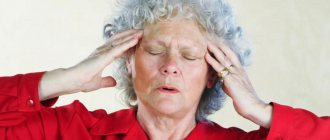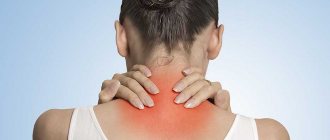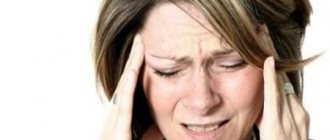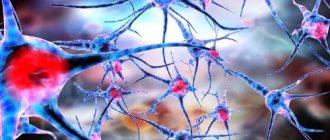Many people do not regard involuntary muscle twitching as a nervous tic and believe that it will go away on its own. It is almost impossible to find information on the Internet that would systematize all the symptoms and at the same time describe the characteristics of a nervous tic or spasms of individual parts of the body.
In our article you can find information about twitching of various parts of the body, their causes and the symptoms of diseases that can cause such phenomena, as well as familiarize yourself with treatment methods.
If you have muscle twitching throughout your body or in certain parts of your body, you should definitely consult a doctor. He will be able to determine whether it is a nervous tic or a seizure. Considering that all human movements must be conscious and coordinated, a nervous tic not only brings discomfort to the perception of one’s body, but can also signal mental, vegetative-vascular and immune diseases. It is worth considering that self-medication will not always be effective, and will often cause irreparable harm; you should consult a doctor. Let's look at individual types of nervous tics and hyperkinesis of various parts of the body in more detail.
Nervous tic
A nervous tic is a muscle contraction that is arrhythmic and involuntary. It can be temporary or permanent. The temporary effect can be caused by strong feelings, fear or a pinched nerve. And a permanent tic is formed due to a lack of microelements after illnesses. Types of nervous tics and hyperkinesis: - Grinding of teeth. - Twitching of the wings of the nose. - Brief twitching of the muscles of the limbs. - Shaking head. — Nervous tic from hyperkinesis in sleep.
Ticks are also divided depending on their location: - Local tics manifest themselves in the contraction of one muscle group. - A generalized tic combines the simultaneous contraction of several groups at once, and at the same time they begin and stop simultaneously.
Types of muscle contractions and possible pathologies
Muscle contractions and twitches are divided into 3 main types. Moreover, they can develop both at rest and during physical activity.
Classification:
- Isotonic. With this type, the muscle decreases. In this case, there is no tension. Most often, contraction occurs when a tendon ruptures.
- Isometric. This type of contraction is characterized by increased tension without significant changes in muscle length. The disorder occurs when trying to lift a heavy load.
- Auxotonic. This type of contraction is caused by an increase in muscle length with increased tension. The disorder develops during a person’s work activity. This type of contraction is in turn divided into eccentric and concentric. The first type of disorder develops when the muscle lengthens, the second is a consequence of shortening the length.
By the nature of muscle spasms, one can determine what pathologies a person has, as well as what problems these contractions can lead to.
Possible diseases:
- pathologies of rheumatic origin;
- injuries and damage – sprains, ruptures;
- convulsive syndrome;
- various forms of myositis - inflammatory processes developing in the muscle area;
- chronic progressive neuromuscular diseases (myopathies);
- deficiency conditions associated with a lack of nutrients and vitamins in the body.
Based on the disorder, the optimal treatment method is selected.
Consequences of muscle twitching
The causes of nervous tics can be:
- lack of vitamins and microelements such as potassium or iron;
- head injury;
- prolonged emotional and mental stress;
- strong feelings;
- pinched nerve;
- neuralgia or vegetative-vascular dystonia.
Consequences that can result from lack of treatment for nervous tics:
- pinched nerves and increased muscle tension;
- if the cause of a nervous tic is vegetative-vascular dystonia, then the result may be a circulatory disorder;
- a nervous tic caused by excessive physical exertion can lead to convulsions or partial loss of limb mobility.
Prevention of hand tremors
Recommended as a preventive measure
- playing sports;
- daily relaxation sessions;
- exercises to improve fine motor skills - embroidery, knitting, wood carving;
- taking soothing tinctures of valerian and other plants (periodically alternating medications).
When an attack begins, you should pick up the object and move it from side to side several times (back straight, arms down 30 degrees). To get better, you need to follow a regimen, stop smoking, quit alcohol, limit the consumption of spicy, salty and caffeine.
If you have determined why your hands are shaking, you should immediately begin treating the underlying disease by limiting physical activity. Only following doctors' recommendations will lead to an improvement in the situation.
Why does involuntary twitching of the muscles of the arms and legs occur?
Considering that the muscles of these parts of the body are most involved in everyday life, their twitching can be caused not only by psycho-emotional, but also by strong physical stress. For example, after a long workout with weights, a phenomenon such as twitching of the muscles of the arms and legs may be observed. As a rule, such phenomena go away on their own within a few days. However, if the twitching continues for a long time, you should definitely consult a doctor, first of all, a therapist, who will determine the need to consult a neurologist, psychologist or neurosurgeon.
Types of seizures
If involuntary contraction of muscle fibers is caused by overexcitation of the cortical part of the brain, such convulsions are classified as epileptic. Non-epileptic ones are provoked by diseases of the central nervous system, imbalance of nutrients, and unfavorable external conditions.
Also, involuntary muscle contractions can be classified according to their nature:
- tonic – long-term, turning into a state of tension;
- myoclonic – short;
- clonic - jerky, cyclically repeating and alternating with relaxation.
Based on localization, these phenomena are divided into generalized and local. The former cover a significant part of the body (arms, legs, face, neck, side, torso, and sometimes extend to the respiratory tract). The latter occur in separate areas (for example, only in the back or only in the buttock).
Why does the shoulder muscle twitch?
Spontaneous twitching of the muscles of the shoulder joint can be caused by physical activity. This phenomenon is usually observed in athletes or people whose profession is related to loading and unloading. If the twitching is constant, then it may be due to a lack of potassium in the body. In this case, after consulting a doctor, drug treatment, including vitamin therapy, will be prescribed. In addition, twitching of the left shoulder may be associated with heart disease, so if such a symptom occurs, it is recommended to consult a physician or cardiologist.
Treatment of the problem
Treatment of diseases caused by muscle spasms is complex and depends on the established cause of their development.
Taking medications
To eliminate negative symptoms, various drugs that are included in the mandatory therapeutic complex can be prescribed.
Fund groups:
- Muscle relaxants: Tinazil, Baclofen.
- Antispasmodic drugs: Spazgan.
- NSAIDs: Diclofenac, Ibuprofen.
- Potassium preparations: Panangin.
As a supplement, various vitamin complexes can be prescribed that contain increased amounts of potassium and other minerals and vitamins, the deficiency of which was discovered during diagnosis.
When swelling develops, the specialist prescribes a course of diuretics (diuretics). However, their use is only possible in conjunction with such agents as Panangin or Asparkam. This eliminates the side effects of diuretics.
Massage treatments
Massage procedures can eliminate muscle tension, reduce the number of spasms and increase the elasticity of blood vessels.
Systematic massage also improves tissue trophism, reduces swelling, improves microcirculation and reduces any discomfort, including pain.
It is recommended to use the following techniques as independent exercises:
- Shaking. You need to stand up straight and relax your whole body. Then they begin to perform light vibrating actions. Execution time – 5 minutes. in a day. Exercise helps reduce hypertension and restore blood circulation.
- Alternating tension and relaxation. This will allow better control of muscle functions. The essence of the technique is to alternately tense and relax the limbs or joints.
To enhance the therapeutic effect, the doctor may prescribe additional physical procedures:
- Electromagnetic radiation. The procedure allows you to improve tissue trophism, relieve spasms and restore blood microcirculation.
- Electrophoresis. This type of therapy allows you to more effectively influence the problem area. In this case, relaxing drugs are used that help eliminate tics and involuntary muscle contractions.
- Acupuncture. Acupuncture helps restore blood circulation and transmission of nerve impulses.
Other procedures may also be used. For example, mud baths or paraffin baths. The number of sessions and duration of therapeutic intervention is determined individually according to the established type of disorder.
Psychotherapeutic methods
Muscles twitch at rest also for reasons that are neurological or psychosomatic in origin. Psychotherapeutic treatment is prescribed only after all examinations and the exclusion of infectious, toxic or other organic causes of pathology.
Various relaxing drugs are used as therapy, the action of which is aimed at enhancing inhibitory reactions and processes. Additionally, work is carried out with patients. The specialist finds out the painful sensations and causes of psychosomatic problems that contributed to the development of spasms.
Exercise therapy
To eliminate involuntary muscle contractions, exercise therapy (physical therapy) is prescribed as an additional treatment. The specialist selects a set of exercises that is aimed at improving microcirculation and trophism in the body, depending on the location of the problem.
Exercises for the back and neck:
- Stand up straight with a straight spine and begin to alternately make movements, first with your left, then with your right shoulder.
- Exercise "Cat". To perform it, you need to get on all fours and rest all your limbs on the floor. Then you should round and arch your back.
- Lie on the floor and clasp your hands together. After this, you need to try to stretch your head up as far as possible, while simultaneously stretching your arms back.
- Stand up straight, tilt your body and begin to stretch your arms forward.
For legs and arms, it is recommended to perform various complexes that are aimed at stretching the muscles. They should be performed carefully and under the supervision of a specialist.
As an additional method, the so-called Drevmass simulator can be used, which is often used for various problems with the spine. If necessary, you can practice breathing exercises to help you relax and calm your mind and body. This gymnastics is useful for any type of disorder.
Nutrition
Muscles twitch at rest not only due to any internal disorders, but also as a result of a deficiency of various useful substances in the body, especially potassium.
In this regard, it is also necessary to adhere to proper nutrition. The diet should include foods rich in vitamins and minerals.
What to use:
- Dairy products and seafood. These products are rich in phosphorus, which is necessary for the normal reaction between the central nervous system and muscle fibers.
- Fresh vegetables and fruits. They contain a large amount of useful substances, including potassium, the lack of which can lead to the development of muscle tics.
- Cereals, cocoa, sesame. These products will help replenish magnesium deficiency in the body. It is especially useful to use them when prescribing diuretics.
- Fatty fish, algae, yeast. These products contain vitamin D, which helps phosphorus, magnesium and potassium to be absorbed better and faster, and also allows you to remove excess calcium.
You should avoid eating smoked meats, sweets, various processed foods, and coffee. Instead of coffee, it is recommended to drink herbal drinks and infusions. It is also recommended to avoid alcohol.
Traditional methods
To relax tension and eliminate spasms, you can use various methods from traditional medicine. A popular remedy is to apply a warm heating pad or cold compress. The thermal effect allows the muscles to relax and restore local blood microcirculation. Cold compresses reduce discomfort and pain, and also help eliminate swelling.
It is recommended to perform several sessions per day, alternating them. The duration of one procedure is no more than 15-20 minutes. The break between treatments is about 1 hour.
You can also prepare soothing and relaxing infusions. It is recommended to use St. John's wort, hawthorn and yarrow as ingredients. Before using decoctions and mixtures, you must first ensure that you are not allergic to them.
Why does my nose twitch?
Twitching of the nose and involuntary sniffing are quite often caused by psychological experiences. This type of twitching requires a mandatory visit to a neurologist. If such a tic is one-time in nature, it would be advisable to take sedatives and perform calming breathing exercises. Facial massage will also help eliminate nervous tics if they are associated with overstrain of facial muscles.
Why does my head twitch involuntarily?
Head tremors can be caused by various serious diseases:
- multiple sclerosis;
- neuralgia;
- cerebellar disease;
— abuse of alcohol and drugs;
- severe stress;
- side effects from taking various medications.
Such twitchings are divided into benign and malignant.
Benign ones, as a rule, are not associated with any serious diseases and do not cause serious discomfort to the patient. As a rule, this type of tremor occurs in adolescence due to insufficient functioning of the thyroid gland.
Diagnosis of causes:
- special studies of head tremor;
— electromagnetic radiation from the brain;
- Tomography and MRI of the brain.
Diagnostics
Diagnosis includes a visual examination and questioning of the patient.
Additionally, various types of instrumental studies are prescribed:
- Electrocardiogram. Allows you to identify abnormalities in the functioning of the cardiovascular system. Prescribed for suspected heart disease.
- Computed tomography of the brain (CT). The examination helps determine the cause and nature of the disorder.
- MRI. An accurate diagnosis can be made using magnetic resonance imaging. In this case, different parts of the body can be examined, depending on where the source of pathology is located.
In some cases, general blood and urine tests may be prescribed, which makes it possible to exclude an infectious or viral nature of the origin of the disorder.
Why do spontaneous leg tremors occur during sleep?
As you know, brain activity does not stop during sleep. Spontaneous muscle twitching during sleep even received a scientific name - Simmonds' nocturnal myoclonus. Such shudders do not pose any danger to human health; they are directly related to brain activity during sleep. If involuntary shaking of the legs leads to awakening, then we may be talking about Okbom's restless legs syndrome. The main reason why these syndromes arise is neuroses and improper functioning of the subcortical part of the brain. In order to determine what causes such twitching, it is necessary to study the functioning of the blood vessels, as well as the psychological state of the patient. After identifying the cause, we can talk about prescribing treatment. This may include:
- taking sedative and epileptic drugs;
- rest and lack of psychological stress may be indicated;
- massage and muscle relaxation;
- following a diet and taking vitamins.
What to do if muscles twitch on their own
If this problem occurs, first of all, it is worth analyzing the previous few days, if such twitching is of a one-time nature. If a few days before the onset of such a symptom there was severe stress, nervous tension, or a psycho-emotional state, then you need to rest well, do breathing exercises, and such twitching will disappear on its own.
If there are chronic diseases, such twitching may be associated with their exacerbations or the general course of the disease. In this case, it is necessary to contact, first of all, a therapist, who will identify a specialist who is competent to answer the question of why twitching occurs and how to eliminate it.
After consulting a therapist, the cause of twitching can be determined as vitamin deficiency, namely, insufficient levels of potassium and iron in the blood. In this case, the most effective treatment will be vitamin therapy and taking special medications.
If there is a constant or prolonged twitching of a muscle, you should definitely examine the vascular system: do an electro- or tomographic study of the brain, which will give answers to the questions: what is it - a pinched nerve or insufficient blood circulation to the brain, which in turn can cause involuntary twitching muscles of various parts of the body.
If twitching of the muscles of the arms and legs occurs after prolonged strength exercises, first of all, you need to eliminate physical activity and give the muscles a rest. Twitching of this type, as a rule, goes away on its own within a few days and does not recur.
Causes of wandering pain
When all the muscles, bones and joints of the whole body hurt, the search for the causes begins with a visit to the doctor. But in order to know which doctor to go to, you need to take into account the presence of chronic diseases, previous infections or a predisposition to the development of various pathologies.
All provoking factors may be common and characteristic of a specific localization of the symptom. Most often, the causes of wandering pain throughout the body are systemic disorders and pathologies:
- physical overload and muscle strain;
- previous acute respiratory viral infections or infectious poisonings;
- postural disorders and spinal diseases;
- muscle inflammation due to hypothermia;
- constant stress and neuroses;
- various chronic diseases (diabetes mellitus, rheumatism, arthritis, etc.).
These are the most common causes of the symptom. It is possible to determine why the muscles of the whole body hurt only by conducting instrumental diagnostics and examination. Before going to the doctor, you need to assume a provoking factor that may cause pain. To do this, you need to take into account its localization and manifestations.









